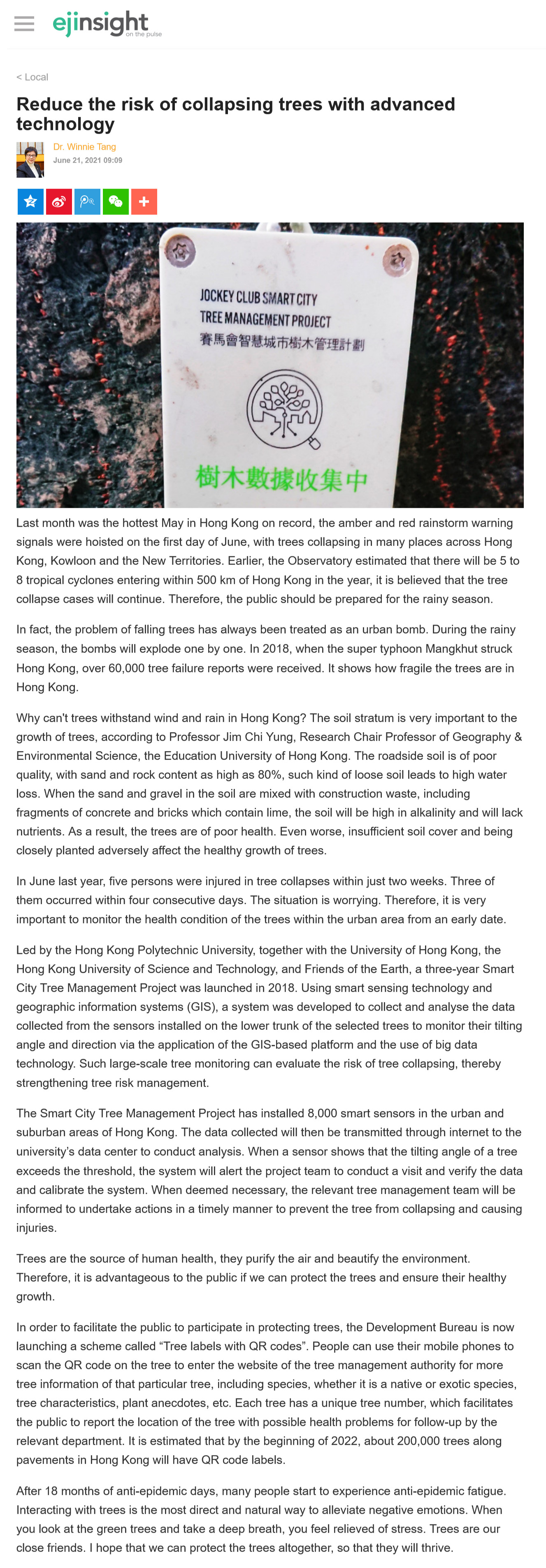網上版請按此

Reduce the risk of collapsing trees with advanced technology
Last month was the hottest May in Hong Kong on record, the amber and red rainstorm warning signals were hoisted on the first day of June, with trees collapsing in many places across Hong Kong, Kowloon and the New Territories. Earlier, the Observatory estimated that there will be 5 to 8 tropical cyclones entering within 500 km of Hong Kong in the year, it is believed that the tree collapse cases will continue. Therefore, the public should be prepared for the rainy season.
In fact, the problem of falling trees has always been treated as an urban bomb. During the rainy season, the bombs will explode one by one. In 2018, when the super typhoon Mangkhut struck Hong Kong, over 60,000 tree failure reports were received. It shows how fragile the trees are in Hong Kong.
Why can't trees withstand wind and rain in Hong Kong? The soil stratum is very important to the growth of trees, according to Professor Jim Chi Yung, Research Chair Professor of Geography & Environmental Science, the Education University of Hong Kong. The roadside soil is of poor quality, with sand and rock content as high as 80%, such kind of loose soil leads to high water loss. When the sand and gravel in the soil are mixed with construction waste, including fragments of concrete and bricks which contain lime, the soil will be high in alkalinity and will lack nutrients. As a result, the trees are of poor health. Even worse, insufficient soil cover and being closely planted adversely affect the healthy growth of trees.
In June last year, five persons were injured in tree collapses within just two weeks. Three of them occurred within four consecutive days. The situation is worrying. Therefore, it is very important to monitor the health condition of the trees within the urban area from an early date.
Led by the Hong Kong Polytechnic University, together with the University of Hong Kong, the Hong Kong University of Science and Technology, and Friends of the Earth, a three-year Smart City Tree Management Project was launched in 2018. Using smart sensing technology and geographic information systems (GIS), a system was developed to collect and analyse the data collected from the sensors installed on the lower trunk of the selected trees to monitor their tilting angle and direction via the application of the GIS-based platform and the use of big data technology. Such large-scale tree monitoring can evaluate the risk of tree collapsing, thereby strengthening tree risk management.
The Smart City Tree Management Project has installed 8,000 smart sensors in the urban and suburban areas of Hong Kong. The data collected will then be transmitted through internet to the university's data center to conduct analysis. When a sensor shows that the tilting angle of a tree exceeds the threshold, the system will alert the project team to conduct a visit and verify the data and calibrate the system. When deemed necessary, the relevant tree management team will be informed to undertake actions in a timely manner to prevent the tree from collapsing and causing injuries.
Trees are the source of human health, they purify the air and beautify the environment. Therefore, it is advantageous to the public if we can protect the trees and ensure their healthy growth.
In order to facilitate the public to participate in protecting trees, the Development Bureau is now launching a scheme called "Tree labels with QR codes". People can use their mobile phones to scan the QR code on the tree to enter the website of the tree management authority for more tree information of that particular tree, including species, whether it is a native or exotic species, tree characteristics, plant anecdotes, etc. Each tree has a unique tree number, which facilitates the public to report the location of the tree with possible health problems for follow-up by the relevant department. It is estimated that by the beginning of 2022, about 200,000 trees along pavements in Hong Kong will have QR code labels.
After 18 months of anti-epidemic days, many people start to experience anti-epidemic fatigue. Interacting with trees is the most direct and natural way to alleviate negative emotions. When you look at the green trees and take a deep breath, you feel relieved of stress. Trees are our close friends. I hope that we can protect the trees altogether, so that they will thrive.
Dr. Winnie Tang
Adjunct Professor, Department of Computer Science, Faculty of Engineering; Department of Geography, Faculty of Social Sciences; and Faculty of Architecture, The University of Hong Kong